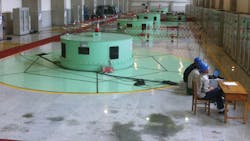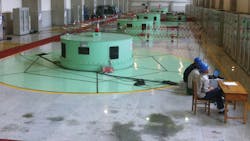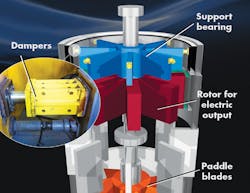Special shock absorbers on hydroelectric turbine shafts are helping to prevent the catastrophic failure of a dam in southeast Asia.
The hydroelectric generator, designed by Harbin Electric Machinery Co., Harbin, China, is several stories tall and houses six 100-MW turbines. Each turbine has a vertically mounted central steel shaft about 3 m in diameter. Paddle blades at the bottom turn the shaft as water flows past. The top of the shaft fits through a guide bearing mounted on the dam’s concrete support structure. This upper bearing stabilizes the top of the turbine and is subject to extreme forces.
During operation, turbulent water flow over the shaft’s paddles sends vibrations up through the shaft. What’s more, the turbine shaft thermally expands a few micrometers during normal operation, magnifying the effect of normal deflections. When these forces travel through the bearing to the fixed supports, they can weaken the dam’s structure.
To prevent this problem, engineers retrofitted the shaft with Visco-Elastic Support (VES) shock absorbers from ITT Enidine Inc., Orchard Park, N. Y. The shocks sit between the guide bearing spokes and the inner diameter of the support structure. A plunger is attached along the main axis of vibration transmission. When forced or loaded, the plunger compacts a chamber filled with a high-viscosity silicon elastomer. The elastomer, a fluid, absorbs shock and vibration energy.
“We use the shocks because the turbines run faster and vibrate more than traditional turbines,” says Dr. Su Zhong, chief architect and chief engineer at Harbin’s Institute of Large Electrical Machinery. The turbines, sitting on Myanmar’s Ruili River have small diameters to save on cost, but that means they turn at 200 rpm or more — compared to only 50 to 100 rpm or so for larger,more traditional turbines. When the Ruili River’s water is high, the dam’s turbines spin faster and vibrate even more. “The VES shocks cut transmitted turbine vibration by half,” says Zhong.
Work to retrofit the other Ruili River generators with VES dampers continues.
Resources: Enidine Dampers
About the Author
Elisabeth Eitel
Elisabeth Eitel was a Senior Editor at Machine Design magazine until 2014. She has a B.S. in Mechanical Engineering from Fenn College at Cleveland State University.


